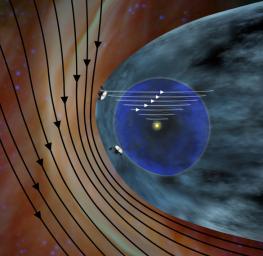
|
Solar and Interstellar Magnetic Fields (Artist’s Concept)
- Click the image above for a larger view
- Full-Res JPEG (1000 x 973) (98.7 kB)
- Full-Res TIFF (1000 x 973) (2.9 MB)
Caption:
This artist's concept shows the different expected directions of the magnetic fields in interstellar space (black lines) and the magnetic field emanating from our sun (white lines). NASA's Voyager 1 spacecraft is traveling northward out of the heliosphere, which is the bubble of charged particles the sun blows around itself. Voyager 2 is traveling southward out of the heliosphere.
Magnetic field lines spiral out from the sun as it rotates. The direction of the magnetic fields lines is believed to be a key indicator of arriving in interstellar space because scientists expect they hit our heliosphere at an angle. Interstellar space is dominated by the explosions of stars millions of years ago, so scientists don't expect the magnetic field lines there will be similar to our sun's. Where Voyager 1 is now, at the edge of our heliosphere, the lines basically run east-to-west, or perpendicular to the spacecraft's direction of travel.
The magnetic field lines pile up in the southern part of our heliosphere, as indicated by the compression of the black lines. They exert more pressure on that part of our heliosphere, giving the heliosphere's nose an uneven shape.
Background Info:
The Voyager spacecraft were built and continue to be operated by NASA's Jet Propulsion Laboratory, in Pasadena, Calif. Caltech manages JPL for NASA. The Voyager missions are a part of NASA's Heliophysics System Observatory, sponsored by the Heliophysics Division of the Science Mission Directorate at NASA Headquarters in Washington.
For more information about the Voyager spacecraft, visit:
http://www.nasa.gov/voyager
and
http://voyager.jpl.nasa.gov
.
Cataloging Keywords:
| Name | Value | Additional Values |
|---|---|---|
| Target | Heliosphere | |
| System | Solar System | |
| Target Type | Heliosphere | |
| Mission | Voyager | |
| Instrument Host | Voyager 1 | |
| Host Type | Flyby Spacecraft | |
| Instrument | ||
| Detector | ||
| Extra Keywords | Artwork, Color, Magnetosphere, Rotation | |
| Acquisition Date | ||
| Release Date | 2012-12-03 | |
| Date in Caption | ||
| Image Credit | NASA/JPL-Caltech | |
| Source | photojournal.jpl.nasa.gov/catalog/PIA16485 | |
| Identifier | PIA16485 | |
